In the winter there is less opportunity to paint or draw on site. I use the time as an opportunity to improve paint technique and use photos or drawings of masters to inspire my artwork. I continue to work on a parsha (Torah portion) image each week. Lately, a few of my favorites have been birds or animals. Also, I joined a group on Facebook which offers prompts for each day. Not every prompt inspires me to paint or draw. But several have, and some of the better ones I will post on my blog or on the art database.
I do not have any pets currently; however, we do have a bird feeder outside our kitchen window. One of the prompts was bird on a wire. I like the idea of drawing directly from nature, but birds are too fast! It is hard to photograph them; you can see some of my past cardinal photos on this blog.
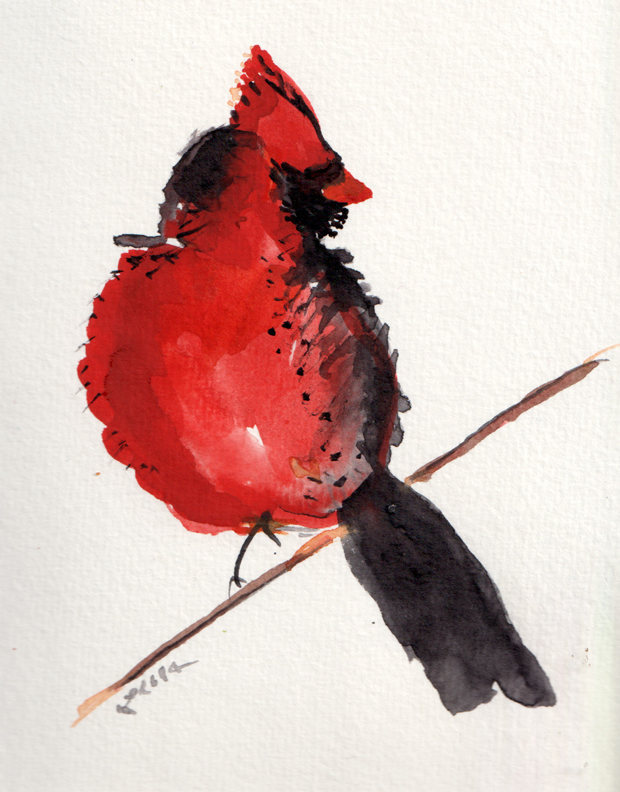
I painted this flaming red male cardinal from one of my photos when the prompt was Bird on a Wire.
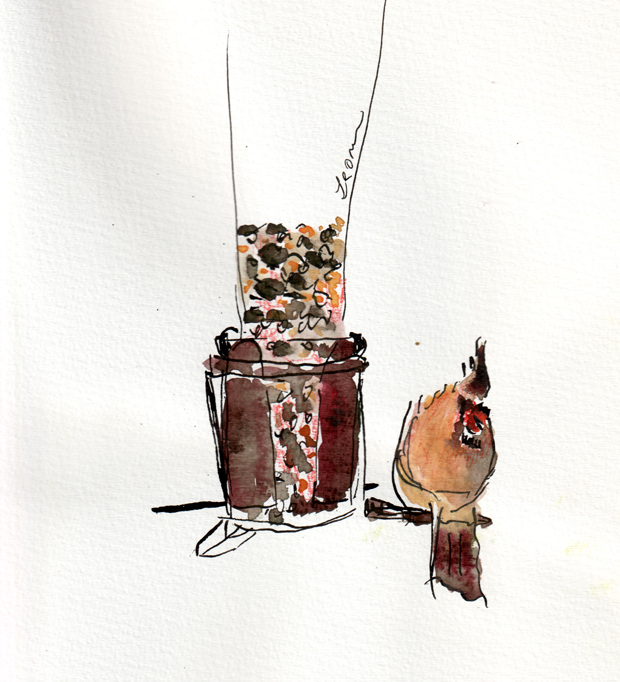
I drew and painted (watercolor, ink, and Derwent Inktense colored pencil on paper) this lady cardinal at a bird feeder in honor of parshat Beshalach, when there is a custom to feed the birds.
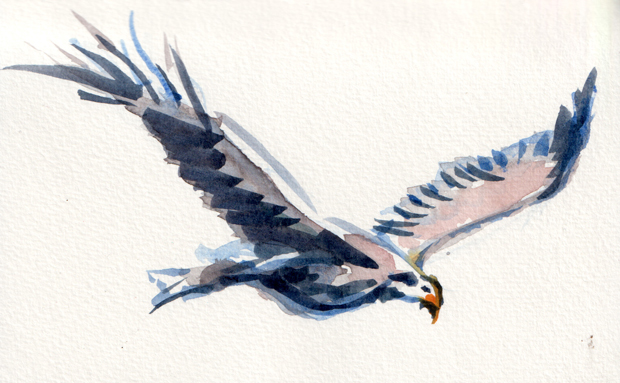
The next week was Parshat Yitro with the quote: And I bore you on eagles’ wings (Exodus 19:4). One eagle is just watercolor on the white of the paper.
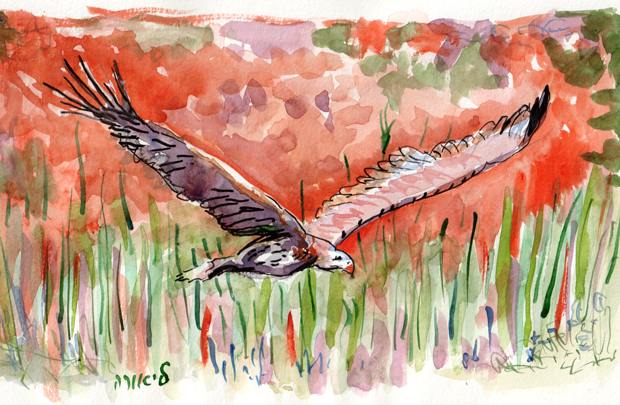
I also did an eagle with an orangey-red background. It came so orange that one friend thought the background was fire. She interpreted it as Israel on fire, and the eagle (perhaps God?) comes to our rescue.
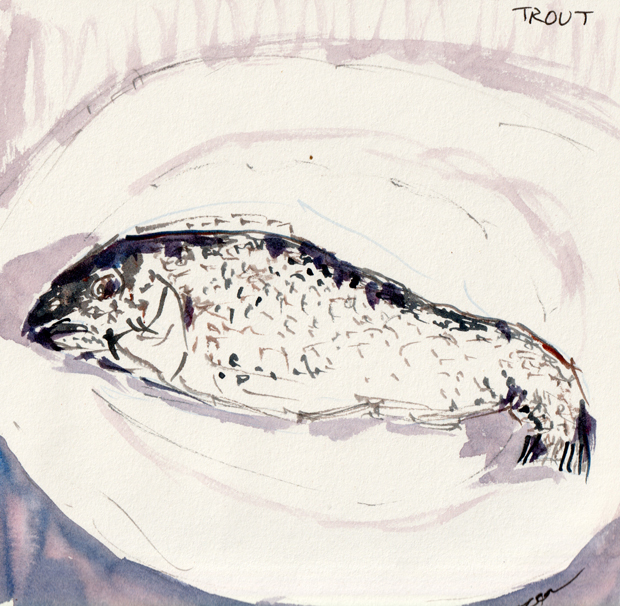
There was a prompt for fish. I painted the trout we had for dinner. Yes, that is all watercolor.

I will conclude with this pencil drawing of a wolf (copy of a drawing by Victor Ambrus), executed for parshat Vayechi 49:7.
Benjamin is a ravenous wolf;
In the morning he consumes the foe,
And in the evening he divides the spoil.”
בִּנְיָמִין֙ זְאֵ֣ב יִטְרָ֔ף בַּבֹּ֖קֶר יֹ֣אכַל עַ֑ד וְלָעֶ֖רֶב יְחַלֵּ֥ק שָׁלָֽל׃

Have you ever been to a paint night? What did you paint? Was it a learning experience, or were you just given some paints and told: “here ya go.”
This past year I was privileged to host two paint nights. For the first one, I did a slide show. I showed perspective, a value study, and a possible finished project. I got feedback later: “I wanted more instruction.”
So when I had the opportunity to host a paint night for a smaller crowd recently, I decided to teach people one on one or in small groups. I publicized the paint night with a poster; I painted the Tsfat or Safed scene that I photographed years ago as a border. The materials given out were acrylic paints, not the sort of paints I have used much. I handed out pencils and some paper, and I showed the participants how to divide up the page into parts, so what they thought was a difficult subject became easier to handle. I pointed out the natural mountains at the top of the scene and the architectural, man-made elements below. Some chose to just paint the mountains. A few tackled the whole scene and did both. Others just played with the paints and chatted with their friends.
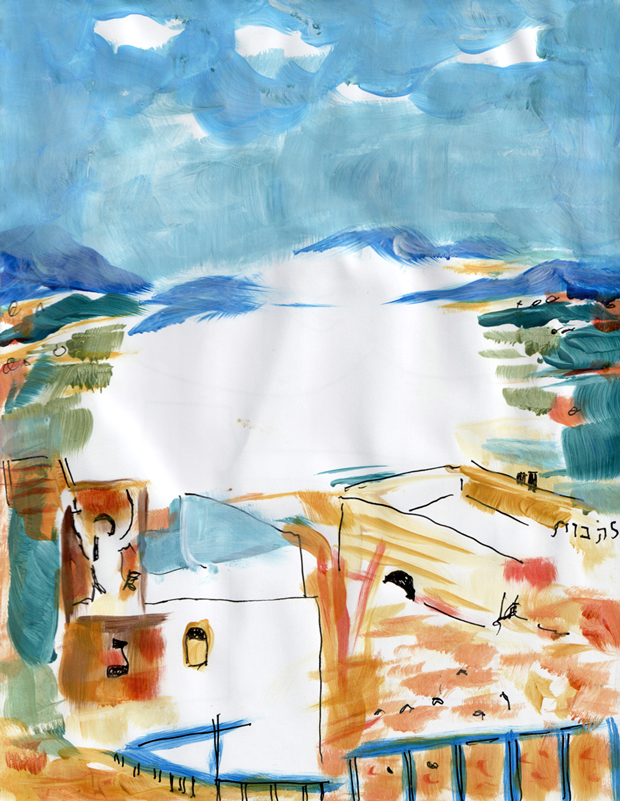
This was my first attempt at a border for advertising the paint night. I made the white too small.
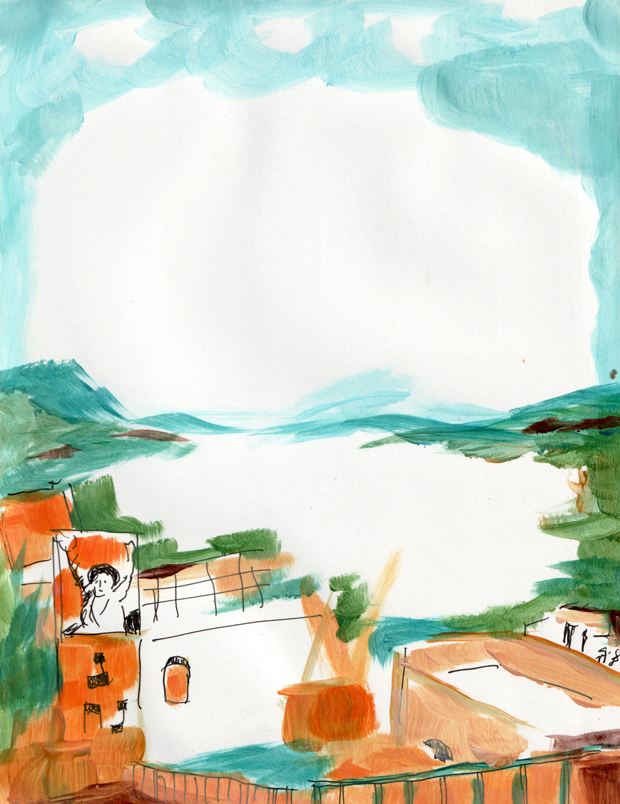
So I painted again, and this one became the border for the details of the paint night.
At the top of this post is a watercolor that I painted from the Tsfat or Safed scene that I chose as the subject for the paint night. Since there has been a lot of upsetting news coming from Israel lately, we went with an Israeli theme for the paint night.
Due to the disheartening news, I decided to post a subject that was Israeli but warmer in nature. I revisited a photograph that I had taken years ago of Yemin Moshe, an old, elegant neighborhood outside of the Old City of Jerusalem. I did an interpretation in gouache:
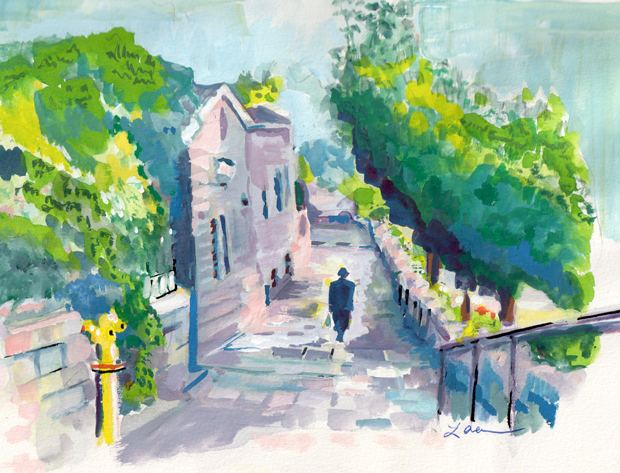
Getting back to posters, I have been publicizing a series of talks by our local rabbi. Each one is a “parshat hashavua” or Torah portion of the week. For each poster I read the Torah portion well in advance and look for visual ideas that I can put in a poster. In the Torah portion of Hayei Sarah, Rebecca feeds not only Eliezer but also his camels. Camels! I took out children’s books about camels from the library, and I had fun drawing and painting a few camel scenes.

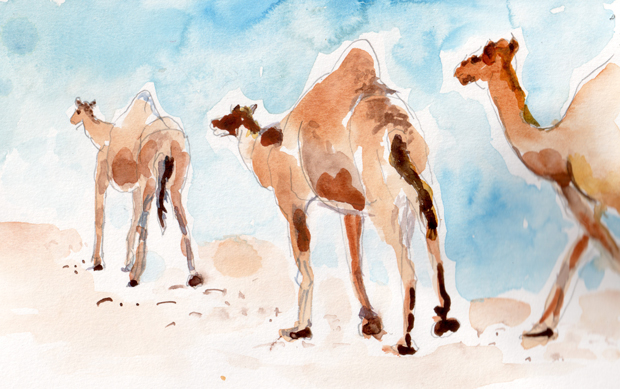
Back to paint night: I have two ideas for upcoming ones:
- Teach how to mix a palette of hue, tint, shade (color, lighter version of that color, darker version of color). Start with a blue, red, and a yellow (primary colors).
- Only black: only allow black for the first half an hour. Then they get treated to pink, turquoise, and lavender/purple.
The inspiration for the only black paint night was a participant wanted some black paint. I had left out the black paint on purpose, so students would mix their own darks. It got me thinking: how could we make good use of black? Using only black would force the students to think about darks and lights. Am I being too strict?
What would you want to learn at a paint night?
If you want to purchase one my painting as a print, visit the store.
If you want to subscribe, sign up for the mailing list.
Autumn: what comes to mind? Oranges, yellows, and deep reds. Colorful leaves, first on the trees, fall down and scatter the streets with their inviting hues.

I was walking outside. I saw this leaf. I picked it up and put it on my dining room table, next to my watercolor paints and brushes. A day or two later, this painting emerged.
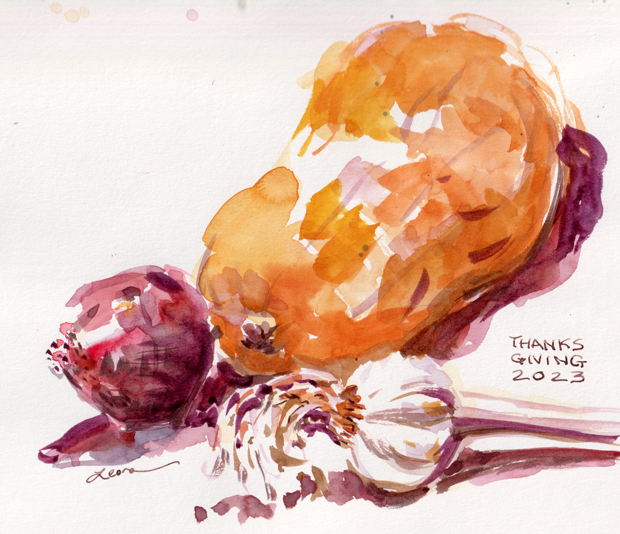
Thanksgiving is a time for family, food, and more of those mustard-y, yellow, orange, and red hues. I had a butternut squash in my kitchen. Nearby was a purplish red onion. They called to me. I buy plenty of garlic from a farmer at the Highland Park Farmers Market, so I added it to the still life. It was nice to take time to paint, as the next week I only had time to cook!

Autumn in Jerusalem is more subtle. Snow is rare; cold rain is what one can expect, in a good year that has no drought. My friend Ahuva Bokow photographed a beautiful scene of a bench by a wall with colorful ivy. I decided it would be the perfect end to this post on autumn colors.
Unlike summer for the rest of the world, summer in the Jewish calendar is a time of sadness. In the month of Tammuz, we remember the siege of Jerusalem. In the month of Av, we mourn the holy Temple, the Bait HaMikdash, that was destroyed not just once but twice. There is a custom not to listen to music during the three weeks between the 17th of Tammuz (siege of Jerusalem) and the 9th of Av (destruction of the Temple).
Painting Music
By the 15th of Av, however, the sadness turns to joy. One of the ways humans experience joy is listening to music. I was fortunate to attend not one concert but two concerts around that time. Rugburn, a band that plays jazz, funk, and rock music, held a concert in local Donaldson Park, so I had a great time not just drawing the musicians’ movements but also adding in the surroundings. The Imperial Band of South River plays pop and classical music in the Imperial Music Center of South River; a friend plays with the Imperial Band each month, and I finally had a chance to attend, drawing pad and Uniball pen in hand.
For both concerts I took my drawing notebook. I did quite a few drawings of the musicians. In fact, I paid more attention to the bodily swaying of the musicians that I did the notes that came out of the musical instruments.

My favorite from Rugburn is this one with the four players swaying to the music and the beautiful reeds and grasses of Donaldson Park swaying in a variety of colors in the background.
You can see more in the art database: https://www.leoraw.com/artcat/rugburn/
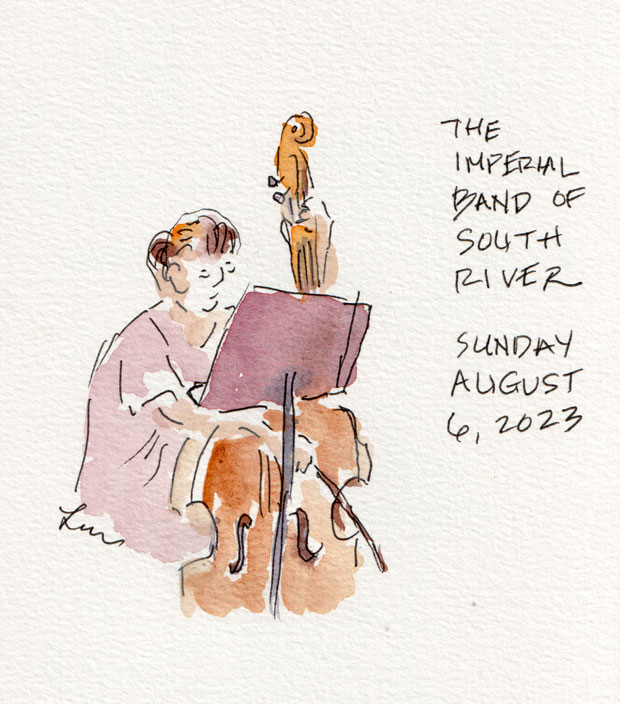
I really like the bass player from the Imperial Band. You can see more of the Imperial Band in the art database.
Preparing for Yom Tov
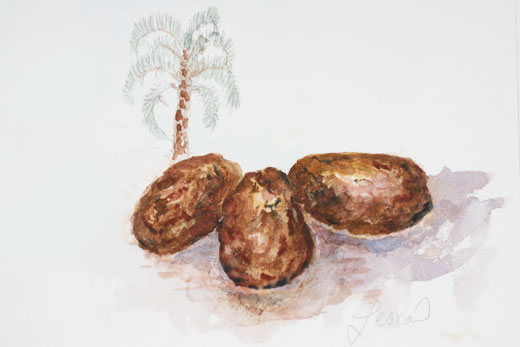
So far, most of my preparation for Yom Tov (holidays) is in my head. I plan to do a Rosh Hashana dinner with as many simanim as I can prepare. Above is a painting of Dates in Front of Palm Tree, watercolor on paper, 2011. Maybe next week I will do a painting of Elul, the Jewish month before Rosh Hashana, which is a time of preparation and asking for forgiveness.
An Art Database
One of the reasons I created an art database is so when potential clients can ask: what works can I buy as prints? I can point to the art database or to a specific category such as Raritan Avenue.
I placed my first order of giclée prints for a client this past week. Giclée is the recommended way to produce archival reproductions of fine art. She had saved screenshots of her favorites my work from the past few years. In the future, I will say to a client: browse through the art database! That’s where one can find illustrations that will work well as prints.

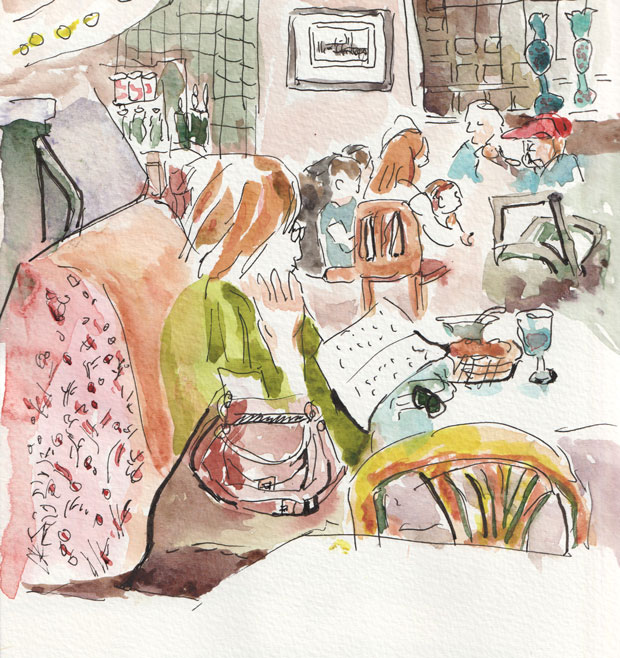
My favorite restaurant is the Bridge Turkish & Mediterranean Grill (kosher) on Raritan Avenue in Highland Park, New Jersey. The staff makes me feel at home. The decor, inside and outside the restaurant, welcomes a painter — there is so much to paint! And I enjoy my food.
I asked a few friends: Have you eaten at the Bridge Restaurant in Highland Park? What is your favorite dish? Can you tell me what you like about the restaurant?
Here are the responses. I interspersed paintings of the restaurant:
“The food is always fresh and flavorful, the staff is very friendly and accommodating. Always a great experience. Favorite food: doner kebab. And the rice on the side is amazing.”
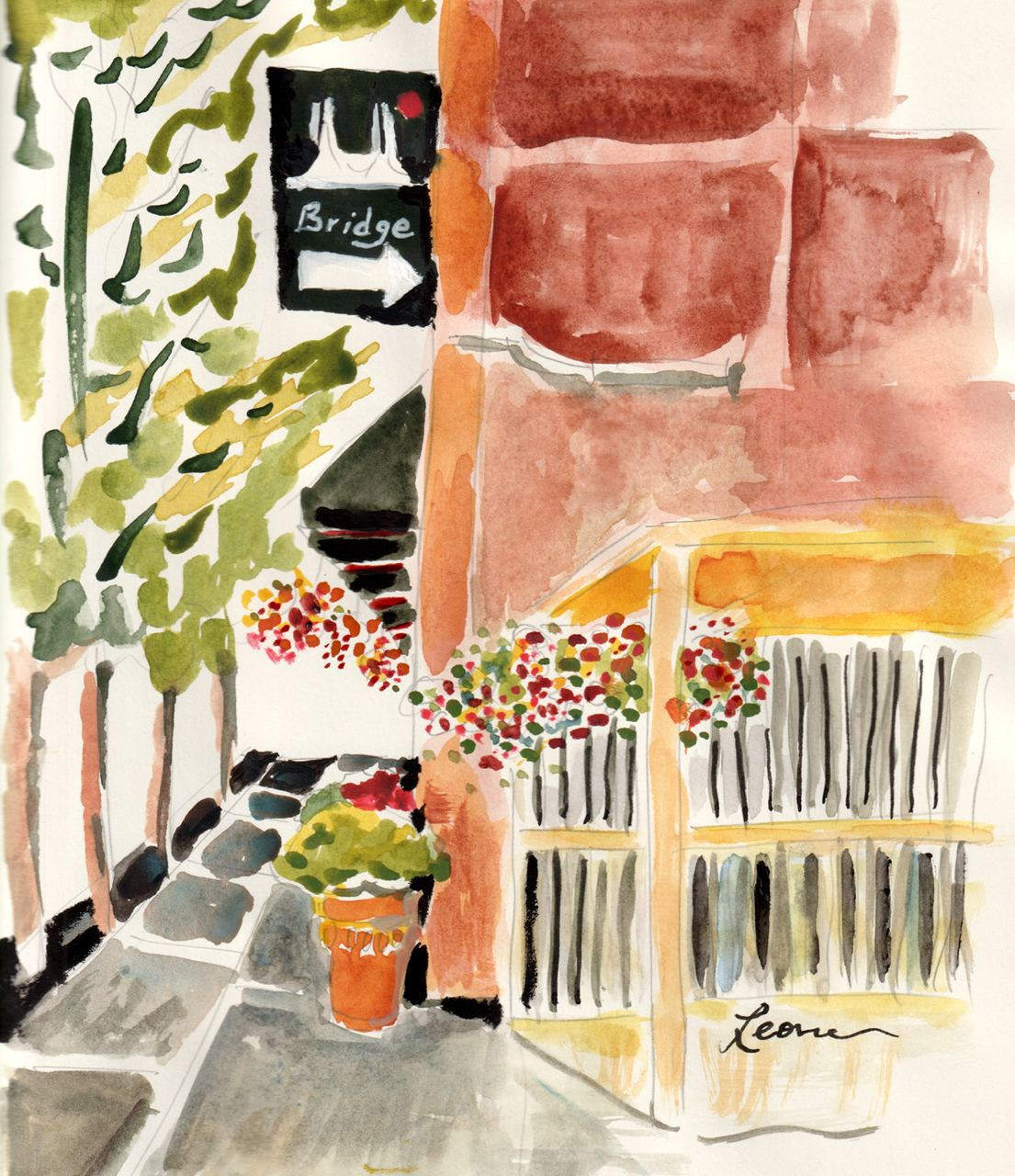
“Always consistently good! they allow you to enjoy your meal–you never feel pressured to rush. Friendly service and knowledgeable wait staff.”
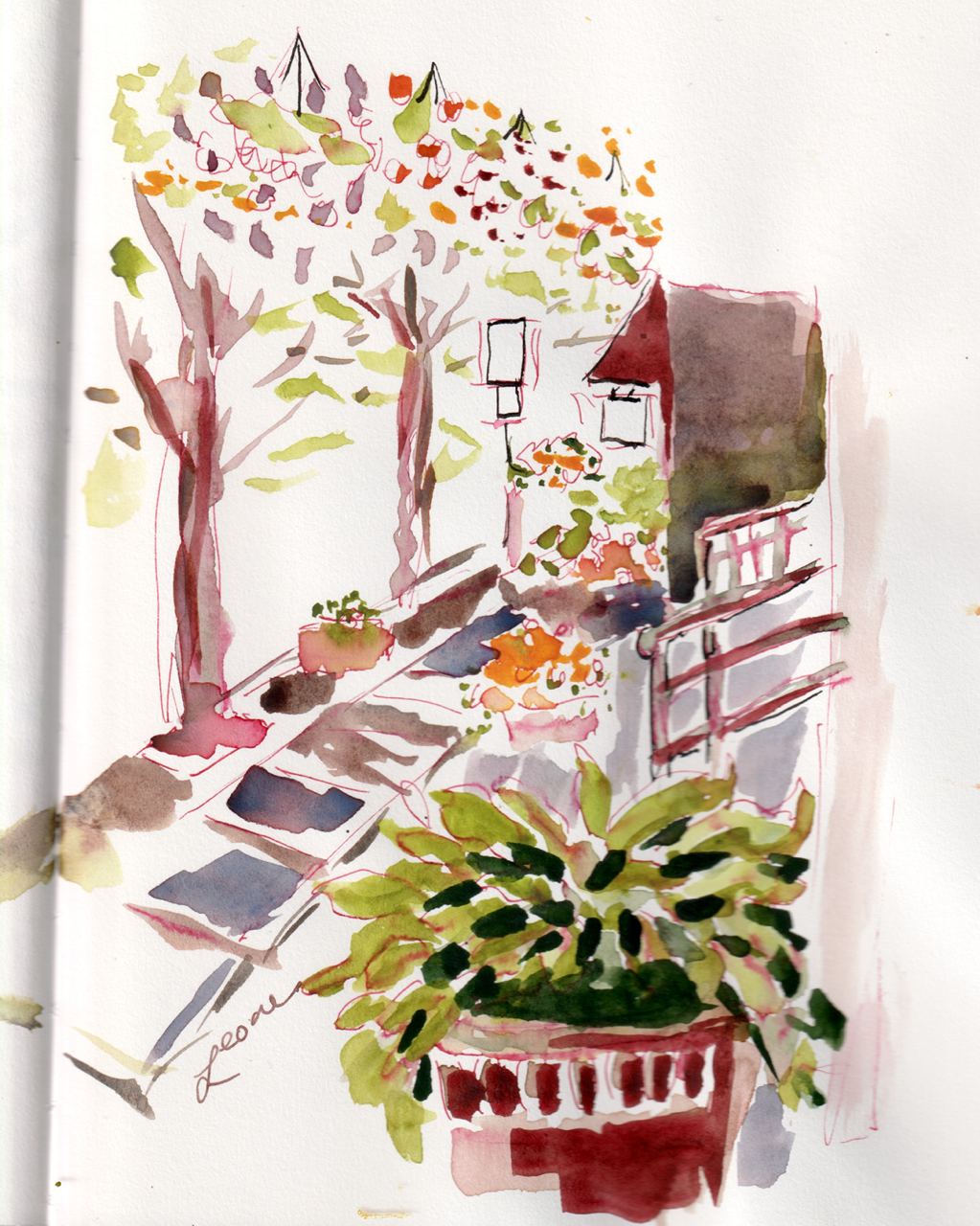
“The food is always fresh, at the right temperature. The staff does not try to rush you and the decor is absolutely perfect…”
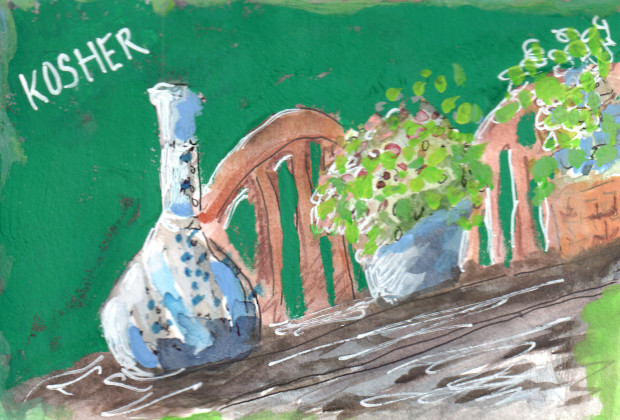
“I particularly enjoy the lentil soup, Mediterranean salad, tahini and their bread is amazing!”
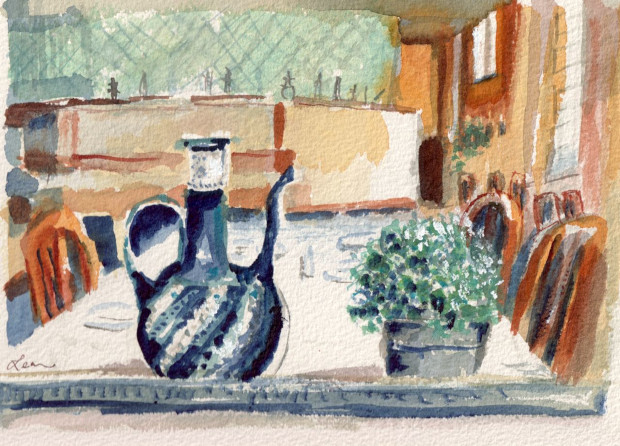
“Love the stuffed roasted eggplant! Rice is amazing! Love the decor: all the vases, plates, etc. Love being greeted by Michael Garber!”
I hope you enjoy this series of paintings and sketches that I have done of the restaurant.
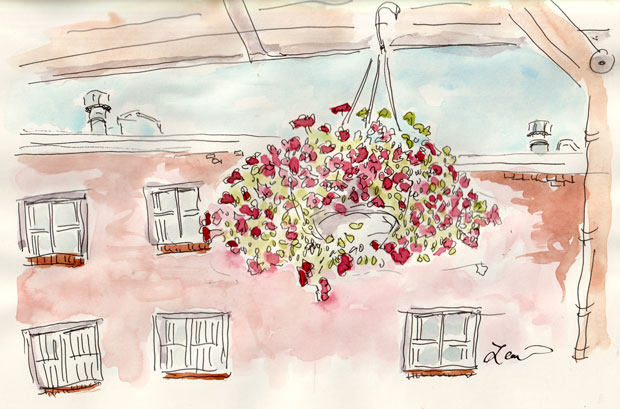
Outside the restaurant there is a little booth where one can be served and eat the delicious food. The hanging flowers are attractive and warm my heart.

























